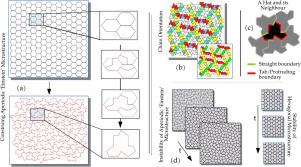演化的爱因斯坦:作为多晶微结构的非周期单晶的不稳定性
IF 2.9
Q2 MATERIALS SCIENCE, MULTIDISCIPLINARY
引用次数: 0
摘要
最近爱因斯坦单晶的发现使设计一类具有一系列有趣的物理和机械性能的新型无序材料成为可能。当这种单晶材料的特征形状发生改变时,相关无序材料的性质也会发生显著变化。因此,帽基无序材料的适用性与其瓦片的热力学稳定性是耦合的。鉴于这一意义,本文通过热力学一致的多相场方法研究了非周期帽基微观结构的稳定性。分析表明,非周期帽状微观结构作为多晶体系具有固有的不稳定性,并逐渐向具有直界面的常规晶粒形态演变,从而消除了其特有的拓扑无序性。这种不稳定性可以追溯到帽状微观结构的晶界网络,其特征是能量不利的四结和突起,它们诱导转变为低能态。尽管在形态上是相同的,在进化过程中,帽子产生不同的拓扑特征或面类的颗粒,由邻居决定,另外,它们的方向。对演化的详尽分析有助于在能量最小化演化开始之前预测多晶帽微观结构中的不稳定瓦片。目前的工作最终揭示了,与传统的多晶系统相反,非周期单晶微观结构中的晶粒生长是由取向决定的,这相应地建立了不同的邻居。本文章由计算机程序翻译,如有差异,请以英文原文为准。

Evolving Einstein: The instability of aperiodic monotile as a polycrystalline microstructure
The recent discovery of the Einstein monotile has enabled the design of a new class of disordered materials with interesting range of physical and mechanical properties. When the characteristic shape of this monotile alters, the properties of the associated disordered materials varies noticeably. Therefore, the applicability of the hat-based disordered material is coupled with the thermodynamic stability of its tiles. Given this significance, the stability of the aperiodic hat-based microstructure is investigated in this work through a thermodynamically consistent multiphase-field approach. The present analysis reveals that the aperiodic hat microstructure, when treated as a polycrystalline system, is inherently unstable, and is progressively evolving towards a conventional grain morphology with straight interfaces, thereby erasing its characteristic topological disorder. The instability is traced to the grain-boundary network of the hat microstructure, characterised by the energetically unfavourable quadruple-junctions and protrusions, which induce a transformation to a lower-energy state. Despite being morphologically identical, during the evolution, the hats yield grains of varied topological feature or face-classes dictated by the neighbours and additionally, their orientation. The exhaustive analysis of the evolution lends itself in predicting the unstable tiles in the polycrystalline hat microstructure before the energy-minimising evolution sets-in. The present work ultimately unravels that, as opposed to conventional polycrystalline systems, grain growth in the aperiodic-monotile microstructure is dictated by orientation, which correspondingly establishes varying neighbours.
求助全文
通过发布文献求助,成功后即可免费获取论文全文。
去求助
来源期刊

Materialia
MATERIALS SCIENCE, MULTIDISCIPLINARY-
CiteScore
6.40
自引率
2.90%
发文量
345
审稿时长
36 days
期刊介绍:
Materialia is a multidisciplinary journal of materials science and engineering that publishes original peer-reviewed research articles. Articles in Materialia advance the understanding of the relationship between processing, structure, property, and function of materials.
Materialia publishes full-length research articles, review articles, and letters (short communications). In addition to receiving direct submissions, Materialia also accepts transfers from Acta Materialia, Inc. partner journals. Materialia offers authors the choice to publish on an open access model (with author fee), or on a subscription model (with no author fee).
 求助内容:
求助内容: 应助结果提醒方式:
应助结果提醒方式:


